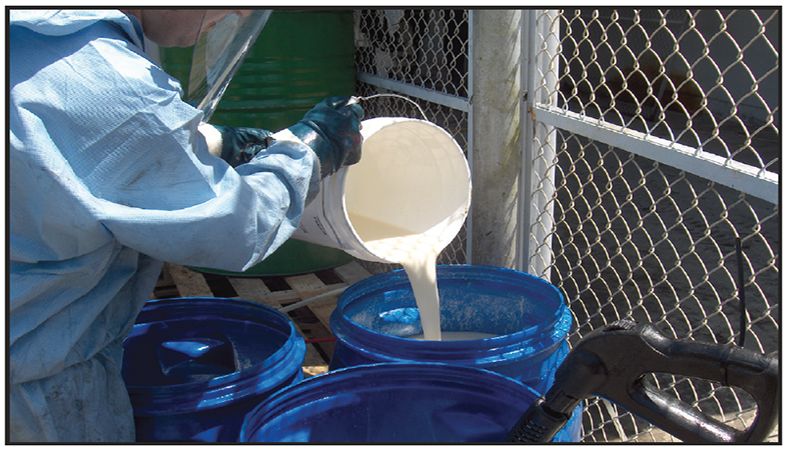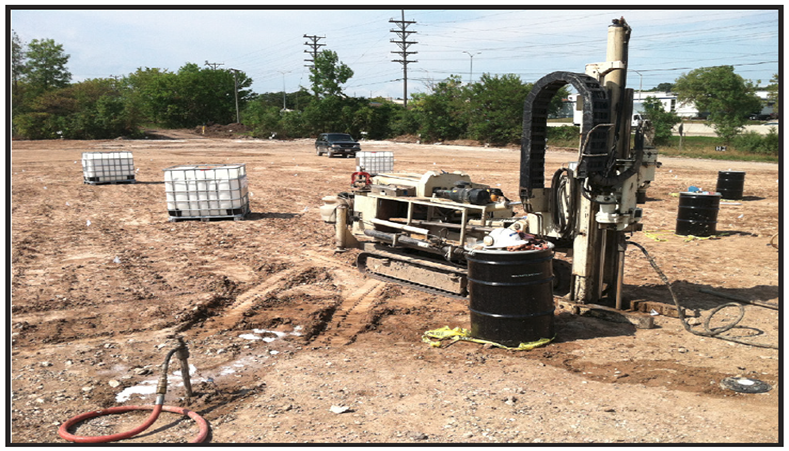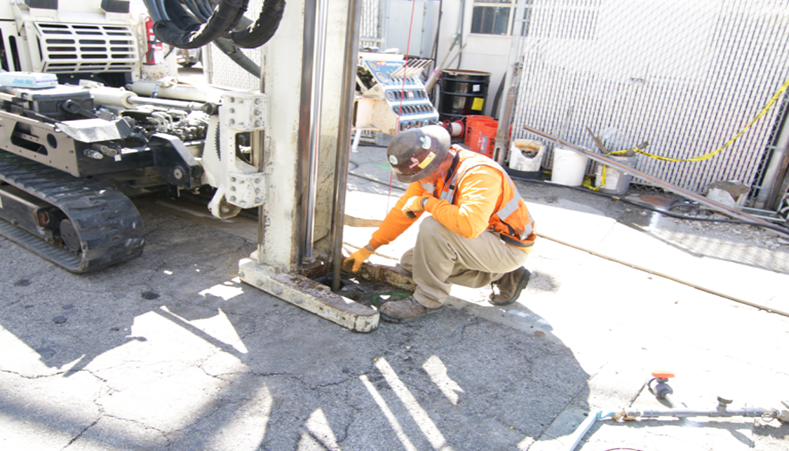Combined Remedies Treat Chlorinated Solvents at Gulf Coast Superfund Site
Former Industrial Facility and Landfill Pilot Test Shows Rapid Reduction in PCE, TCE and 1,2 DCE
Project Highlights
- Superfund Site once housed an industrial facility and landfill.
- Rapid reduction needed to avoid off-site migration of daughter products.
- Simultaneous application of Enhanced Aerobic Biodegradation, Bioaugmentation and In Situ Chemical Reduction (ISCR).
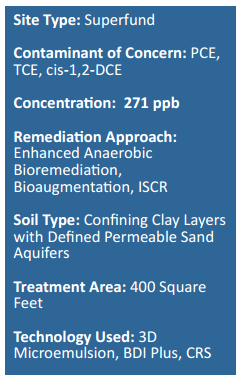
Project Summary
This former industrial property had a landfill that was used in the mid-1900s for disposal of magnesium dross and refractory brick as well as breakout material from electrolytic chlorine cells. As much as 254,000 cubic feet of material were removed from the landfill although a large chlorinated solvent plume remains both from landfill waste below the water table and from industrial operations on-site. A feasibility study for the site was approved in 2012 which evaluated the use of enhanced reductive dechlorination to treat dissolved chlorinated solvents at the site and to prevent off-site migration past the property boundary and beneath a highway. A pilot test to evaluate at least two different biological amendments was conducted and Regenesis supplied 3D Microemulsion, BDI, and CRS for the evaluation. Three aquifers exist at the site, but the pilot test was performed in the first groundwater bearing unit only.
Remediation Approach
After a review of sulfate concentrations, other natural attenuation data, and cVOC concentrations it was determined that the optimal treatment choice would be to test a combination of an electron donor in the form of 3-D Mircoemulsion®, a bioaugmentation culture called Bio-Dechlor INOCULUM® Plus, and the use of Chemical Reducing Solution® (CRS) to prevent any hydrogen sulfide toxicity and to promote a level of beneficial in situ chemical reduction (ISCR). For the pilot test 10 injections points were used to place 800 pounds of 3-D Microemulsion, 18 liters of BDI Plus and 400 pounds of CRS. The product was injected over a 10-foot interval.
The goal for this project was to attain as rapid reduction as possible for the site specifically to avoid off-site migration of daughter products such as vinyl chloride. Therefore, it was deemed beneficial to inject all three proposed products at once. The product was injected in March 2014 and results at roughly 1 month post injection are extremely promising. PCE has been reduced from 134 ppb to 1.57 ppb, TCE from 271 ppb to 1.77 ppb, and cic-1,2-DCE from 235 ppb to 4.25 ppb. Vinyl Chloride has shown some increase from non-detect to 13 ppb.
However, Dehalococcoides has increased from non-detect to 7 x 10×5 cells/bead and vinyl chloride reduced from nondetect to 9 x 10×4 cells per bead which strongly correlates to the rapid enhanced reductive dechlorination.
Technology Description
3-D Microemulsion is an engineered electron donor material that offers a novel 3-stage electron donor release profile, pH neutral chemistry and is delivered on-site as a factory emulsified product.
BDI Plus is an enriched natural microbial consortium containing species of Dehalococcoides sp. (DHC). This microbial consortium has since been enriched to increase its ability to rapidly dechlorinate contaminants during in situ bioremediation processes.
CRS (Chemical Reducing Solution) is an iron-based amendment for in situ chemical reduction (ISCR) of halogenated hydrocarbon contaminants such as chlorinated ethenes and ethanes.
Combined Remedies Treat Chlorinated Solvents at Gulf Coast Superfund Site
Former Industrial Facility and Landfill Pilot Test Shows Rapid Reduction in PCE, TCE and 1,2 DCE
Project Highlights
- Superfund Site once housed an industrial facility and landfill.
- Rapid reduction needed to avoid off-site migration of daughter products.
- Simultaneous application of Enhanced Aerobic Biodegradation, Bioaugmentation and In Situ Chemical Reduction (ISCR).
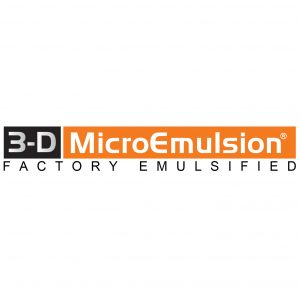
Project Summary
This former industrial property had a landfill that was used in the mid-1900s for disposal of magnesium dross and refractory brick as well as breakout material from electrolytic chlorine cells. As much as 254,000 cubic feet of material were removed from the landfill although a large chlorinated solvent plume remains both from landfill waste below the water table and from industrial operations on-site. A feasibility study for the site was approved in 2012 which evaluated the use of enhanced reductive dechlorination to treat dissolved chlorinated solvents at the site and to prevent off-site migration past the property boundary and beneath a highway. A pilot test to evaluate at least two different biological amendments was conducted and Regenesis supplied 3D Microemulsion, BDI, and CRS for the evaluation. Three aquifers exist at the site, but the pilot test was performed in the first groundwater bearing unit only.
Remediation Approach
After a review of sulfate concentrations, other natural attenuation data, and cVOC concentrations it was determined that the optimal treatment choice would be to test a combination of an electron donor in the form of 3-D Mircoemulsion®, a bioaugmentation culture called Bio-Dechlor INOCULUM® Plus, and the use of Chemical Reducing Solution® (CRS) to prevent any hydrogen sulfide toxicity and to promote a level of beneficial in situ chemical reduction (ISCR). For the pilot test 10 injections points were used to place 800 pounds of 3-D Microemulsion, 18 liters of BDI Plus and 400 pounds of CRS. The product was injected over a 10-foot interval.
The goal for this project was to attain as rapid reduction as possible for the site specifically to avoid off-site migration of daughter products such as vinyl chloride. Therefore, it was deemed beneficial to inject all three proposed products at once. The product was injected in March 2014 and results at roughly 1 month post injection are extremely promising. PCE has been reduced from 134 ppb to 1.57 ppb, TCE from 271 ppb to 1.77 ppb, and cic-1,2-DCE from 235 ppb to 4.25 ppb. Vinyl Chloride has shown some increase from non-detect to 13 ppb.
However, Dehalococcoides has increased from non-detect to 7 x 10×5 cells/bead and vinyl chloride reduced from non-detect to 9 x 10×4 cells per bead which strongly correlates to the rapid enhanced reductive dechlorination.
Technology Description
3-D Microemulsion is an engineered electron donor material that offers a novel 3-stage electron donor release profile, pH neutral chemistry and is delivered on-site as a factory emulsified product.
BDI Plus is an enriched natural microbial consortium containing species of Dehalococcoides sp. (DHC). This microbial consortium has since been enriched to increase its ability to rapidly dechlorinate contaminants during in situ bioremediation processes.
CRS (Chemical Reducing Solution) is an iron-based amendment for in situ chemical reduction (ISCR) of halogenated hydrocarbon contaminants such as chlorinated ethenes and ethanes.
Chlorinated Solvents in Soil, Gas, and Groundwater Remediated at Former Manufacturing Facility
No Further Action” Status Achieved at Ohio Brownfields Site
Project Highlights
- Integrated Site Remediation coupling enhanced reductive dechlorination (ERD) and vapor mitigation was implemented to address the immediate risk of vapor intrusion and the long-term risk of identified CVOCs in groundwater.
- Combined remedy approach allowed site to be redeveloped as an apartment complex roughly 6 months following the groundwater treatment.
- “No Further Action” status and covenant not to sue letter was granted in 2013.
- Cost for groundwater water treatment was approximately $10 per cubic yard (product and application) and vapor intrusion mitigation was $3.34 per square foot with no long term O&M required.
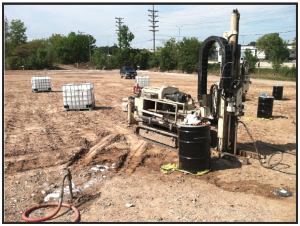
Project Summary
The site, a former industrial magnet manufacturing facility in Ohio, received a $2.34 million Clean Ohio Revitalization Fund grant through the Ohio Department of Development in 2011. Site investigation activities identified chlorinated VOCs in groundwater and vapors above the state regulatory limits. Using a combined approach of ERD with vapor mitigation addressed the immediate risk of vapor intrusion and the long-term risk of groundwater impacts. By implementing this strategy, the site was allowed to be redeveloped as an apartment complex roughly 6 months following the groundwater treatment. “No Further Action” status and covenant not to sue letter was granted in 2013. The site currently operates as a residential apartment complex.
Remediation Approach
In the Spring of 2012, ERD using 3-D Microemulsion® and Bio-Dechlor INOCULUM® Plus was implemented within the defined 24,000-square-foot treatment area via direct-push injection. In Fall 2012, the Geo-Seal™ vapor barrier system was installed below a 15,522-square-foot apartment complex raised at the site. The cost for groundwater treatment was approximately $10/cy (product and application) and Geo-Seal was $3.34/sf (product and installation).
Technology Description
3-D Microemulsion is an engineered electron donor material that offers a novel 3-stage electron donor release profile, pH neutral chemistry and is delivered on-site as a factory emulsified product.
Bio-Dechlor INOCULUM Plus is an enriched natural microbial consortium containing species of Dehalococcoides sp. (DHC). This microbial consortium has since been enriched to increase its ability to rapidly dechlorinate contaminants during in situ bioremediation processes.
Geo-Seal is a composite system that creates the ideal blend between constructability and chemical resistance by using both high density polyethylene (HDPE) and spray applied asphalt latex.
PCE Treated at Active Dry Cleaner in Less Than 200 Days
Project Receives “No Further Action” Letter Following Combined Application of 3-D Microemulsion® and BDI® Plus
Project Highlights
- Enhanced reductive dechlorination used to treat PCE contamination under an active dry cleaning facility
- Total cVOC concentrations reduced by three orders of magnitude in less than 200 days
- Total cVOC concentrations were below remediation goal

Project Summary
Groundwater below a Missouri dry cleaning facility was contaminated from a cleaning solvent spill, resulting in PCE concentrations >4,000 μg/L. An enhanced reductive dechlorination approach was developed that integrated biodegradation and bioaugmentation via application of a controlled-release electron donor and a microbial consortium of dechlorinating bacteria.
REGENESIS® Remediation Services (RRS) was contracted to co-apply 3-D Microemulsion® and Bio-Dechlor Inoculum® Plus to the affected groundwater. The products were applied to the affected groundwater underneath the building via direct-push injections.
Technology Description
3-D Microemulsion factory emulsified is an engineered electron donor material that offers a novel 3-stage electron donor release profile, pH neutral chemistry and is delivered on-site as a factory-emulsified product.
Bio-Dechlor INOCULUM Plus is an enriched natural microbial consortium containing species of Dehalococcoides sp. (DHC). This microbial consortium has since been enriched to increase its ability to rapidly dechlorinate contaminants during in situ bioremediation processes.
Results
Following treatment, total cVOC were reduced by 99.9%. Concentrations were reduced by three orders of magnitude from a baseline concentration of >4,000 μg/L to <10 μg/L in less than 200 days.
Furthermore, monitoring data indicated complete dechlorination with no remaining daughter products above the remediation goals. As a result of the rapid and complete reduction of chlorinated solvents, the project received a “No Further Action” letter (NFA) through the Missouri Department of Natural Resources.
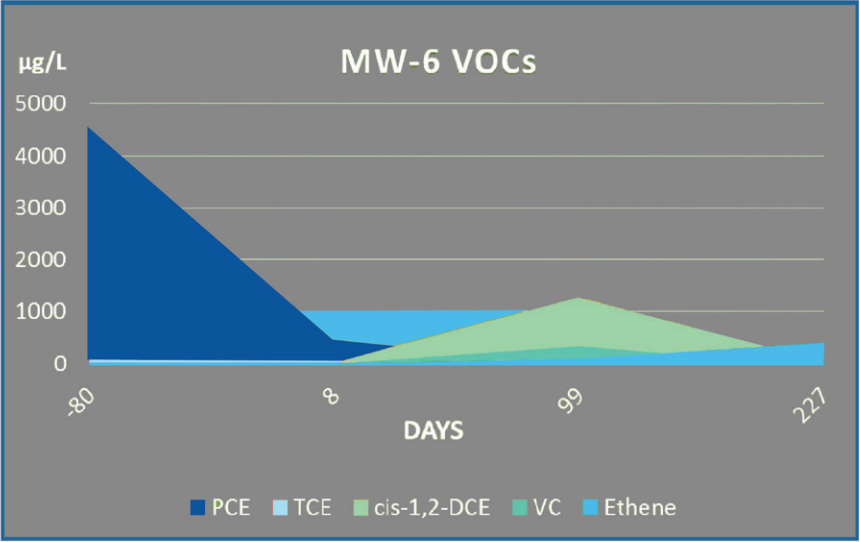
| Download the PDF |
Project Receives “No Further Action” Letter Following Combined Application of 3-D Microemulsion® and BDI® Plus
Project Highlights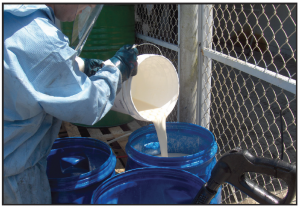
- Enhanced reductive dechlorination used to treat PCE contamination under an active dry cleaning facility
- Total cVOC concentrations reduced by three orders of magnitude in less than 200 days
- Total cVOC concentrations were below remediation goals
Project Summary
Groundwater below a Missouri dry cleaning facility was contaminated from a cleaning solvent spill, resulting in PCE concentrations >4,000 μg/L. An enhanced reductive dechlorination approach was developed that integrated biodegradation and bioaugmentation via application of a controlled-release electron donor and a microbial consortium of dechlorinating bacteria.
REGENESIS® Remediation Services (RRS) was contracted to co-apply 3-D Microemulsion® and Bio-Dechlor Inoculum® Plus to the affected groundwater. The products were applied to the affected groundwater underneath the building via direct-push injections.
Technology Description
3-D Microemulsion factory emulsified is an engineered electron donor material that offers a novel 3-stage electron donor release profile, pH neutral chemistry and is delivered on-site as a factory-emulsified product.
Bio-Dechlor INOCULUM Plus is an enriched natural microbial consortium containing species of Dehalococcoides sp. (DHC). This microbial consortium has since been enriched to increase its ability to rapidly dechlorinate contaminants during in situ bioremediation processes.
Results

Following treatment, total cVOC were reduced by 99.9%. Concentrations were reduced by three orders of magnitude from a baseline concentration of >4,000 μg/L to <10 μg/L in less than 200 days.
Furthermore, monitoring data indicated complete dechlorination with no remaining daughter products above the remediation goals. As a result of the rapid and complete reduction of chlorinated solvents, the project received a “No Further Action” letter (NFA) through the Missouri Department of Natural Resources.
Combined Remedies Used at Former Chemical Company in Illinois, USA
cVOCs in Bedrock Treated at Active Manufacturing Facility
Project Highlights
- Regenesis Remediation Services (RRS) used combined technologies to work toward the shutdown of a pump and treat (P&T) system.
- Previous Enhanced Reductive Dechlorination (ERD) technology applications did not achieve COC reductions.
- Advanced ERD, Bioaugmentation and ISCR remedies were combined and applied into weathered bedrock.
- The project required RRS to be PICS certified. PICS is a contractor prequalification services used many large E&C and fortune 500 companies.
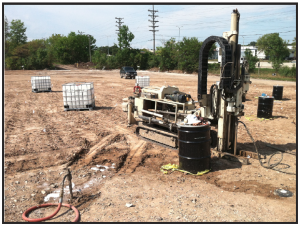
Project Summary
The site is home to an active chemical manufacturing facility with historic spills of cVOCs. Within the contamination impact zones, a groundwater P&T system is being used to mitigate off-site migration of cVOCs in the groundwater. The consultant was seeking ways to turn off the P&T system by treating the plume in-situ. They had previously used an ERD technology without fully achieving primary COC reductions. RRS designed and implemented a pilot study for the site.
Remediation Approach
The pilot study was designed to test Regenesis’ combined remedy approach which incorporated ERD using 3-D Microemulsion, Bioaugmentation with BDI Plus and ISCR with CRS. RRS applied the integrated technologies through direct-push borings. The 2,500-square-foot treatment zone included 10-foot vertical injections into silty sand and clay over weathered dolomite bedrock.
Technology Description
- 3-D Microemulsion is an engineered electron donor material that offers a novel 3-stage electron donor release profile, pH neutral chemistry and is delivered on-site as a factory–emulsified product.
- HRC Primer is a less viscous version of the standard Hydrogen Release Compound (HRC) product. It is a thinner, water-like compound that is typically injected into an aquifer where it releases lactic acid at a rate faster than standard HRC (several weeks), but at a slower, more controlled rate than dispersing aqueous simple sugar solutions or straight lactic acid (several days).
- Bio-Dechlor INOCULUM Plus is an enriched natural microbial consortium containing species of Dehalococcoides sp. (DHC). This microbial consortium has since been enriched to increase its ability to rapidly dechlorinate contaminants during in situ bioremediation processes.
- CRS® (Chemical Reducing Solution) is an iron-based amendment for in situ chemical reduction (ISCR) of halogenated hydrocarbon contaminants such as chlorinated ethenes and ethanes.
Combined Remedies Used at Historic Illinois Chemical Company
cVOCs in Bedrock Treated at Active Manufacturing Facility
Project Highlights
- Regenesis Remediation Services (RRS) used combined technologies to work toward the shutdown of a pump and treat (P&T) system.
- Previous Enhanced Reductive Dechlorination (ERD) technology applications did not achieve COC reductions.
- Advanced ERD, Bioaugmentation and ISCR remedies were combined and applied into weathered bedrock.
- The project required RRS to be PICS certified. PICS is a contractor prequalification services used many large E&C and fortune 500 companies.
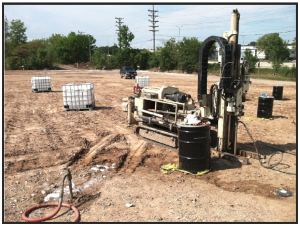
Project Summary
The site is home to an active chemical manufacturing facility with historic spills of cVOCs. Within the contamination impact zones, a groundwater P&T system is being used to mitigate off-site migration of cVOCs in the groundwater. The consultant was seeking ways to turn off the P&T system by treating the plume in-situ. They had previously used an ERD technology without fully achieving primary COC reductions. RRS designed and implemented a pilot study for the site.
Remediation Approach
The pilot study was designed to test Regenesis’ combined remedy approach which incorporated ERD using 3-D Microemulsion, Bioaugmentation with BDI Plus and ISCR with CRS. RRS applied the integrated technologies through direct-push borings. The 2,500-square-foot treatment zone included 10-foot vertical injections into silty sand and clay over weathered dolomite bedrock.
Technology Description
- 3-D Microemulsion is an engineered electron donor material that offers a novel 3-stage electron donor release profile, pH neutral chemistry and is delivered on-site as a factory–emulsified product.
- HRC Primer is a less viscous version of the standard Hydrogen Release Compound (HRC) product. It is a thinner, water-like compound that is typically injected into an aquifer where it releases lactic acid at a rate faster than standard HRC (several weeks), but at a slower, more controlled rate than dispersing aqueous simple sugar solutions or straight lactic acid (several days).
- Bio-Dechlor INOCULUM Plus is an enriched natural microbial consortium containing species of Dehalococcoides sp. (DHC). This microbial consortium has since been enriched to increase its ability to rapidly dechlorinate contaminants during in situ bioremediation processes.
- CRS® (Chemical Reducing Solution) is an iron-based amendment for in situ chemical reduction (ISCR) of halogenated hydrocarbon contaminants such as chlorinated ethenes and ethanes.
Biodegradation Successfully Treats High Levels of PCE/TCE Contamination
Combined Remedies Used to Remediate Active Dry Cleaner in Northern California
Project Highlights
- Pilot study used enhanced biodegradation coupled with bioaugmentation to treat high PCE levels.
- High PCE levels above 5,000 ug/L were detected in groundwater.
- Regenesis optimized injection of the bioamendments into the target treatment zone.
- Significant contaminant reduction resulting from enhanced biodegradation within six months
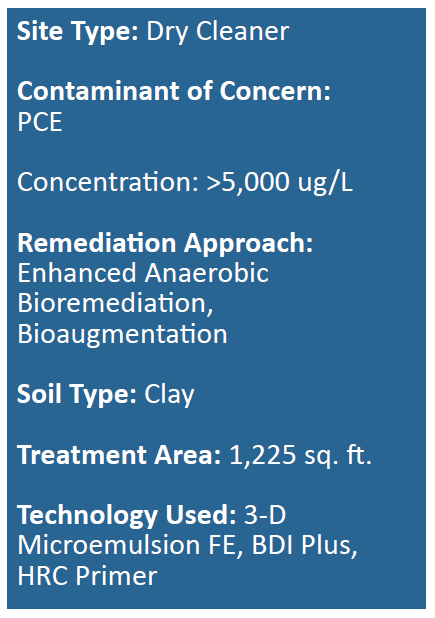
Project Summary
This project was located at an active dry cleaner in northern California. The site had elevated levels of PCE in groundwater due to releases over a period of approximately 60-years. Enhanced anaerobic biodegradation (EAB) was chosen to remediate the site. A pilot study program was implemented using a combination of 3-D Microemulsion®, HRC® Primer and BDI® Plus. Significant contaminant reductions were observed within six months of the first application.
Remediation Approach
An in situ EAB pilot study program was implemented to address elevated levels of PCE concentrations in middle zone groundwater just north of site. 3-D Microemulsion, HRC Primer and BDI Plus were applied through 15 bore holes to depths of 60 feet. Early injection attempts posed challenges due to the formation not accepting the required volume (surfacing). Regenesis provided a modified design reducing the amount of water needed for 3-D Microemulsion and suggested an alternative injection approach in the field which allowed for a more efficient injection within the target treatment zone.
Technology Description
3-D Microemulsion is an engineered electron donor material that offers a novel 3-stage electron donor release profile, pH neutral chemistry and is delivered on-site as a factory emulsified product.
HRC Primer is a less viscous version of the standard Hydrogen Release Compound (HRC) product. It is a thinner, water-like compound that is typically injected into an aquifer where it releases lactic acid at a rate faster than standard HRC (several weeks), but at a slower, more controlled rate than dispersing aqueous simple sugar solutions or straight lactic acid (several days).
Bio-Dechlor INOCULUM® Plus is an enriched natural microbial consortium containing species of Dehalococcoides sp. (DHC). This microbial consortium has since been enriched to increase its ability to rapidly dechlorinate contaminants during in situ bioremediation processes.
ISCO/ERD Treat PCE Contamination at Indiana Dry Cleaner
Remediation Plan Addresses Concentrations Below Facility and Downgradient
Project Highlights
- PersulfOx utilized subslab near the source to inhibit vapor issues within the building.
- Combined remediation plan addressed impacts both below the building and downgradient of the facility.
- PCE contamination was nearly depleted and TCE levels below 10 ppb were observed.
- The site is currently being monitored to demonstrate plume stability with approximately 3-4 more monitoring events prior to site closure.
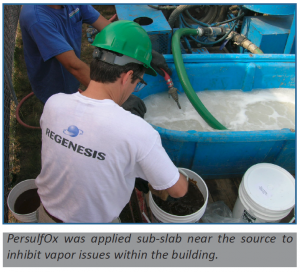
Project Summary
A release of PCE from a former dry cleaning operation in Indianapolis resulted in groundwater contamination below the facility and downgradient. Contamination impacts were also observed in shallow fill below the concrete slab. Along with the groundwater/soil contamination, vapor intrusion was also detected within the facility and adjacent spaces in the strip mall. A combination of enhanced reductive dechlorination (ERD) and in situ chemical oxidation (ISCO) was used for remedial action. Analytical results obtained indicate nearly complete reduction of PCE and less than 10 ppb of TCE in all wells. Currently, elevated VC concentrations in two wells were observed but reductions are expected as the ERD process is completed.
Remediation Approach
PersulfOx® Catalyzed Persulfate was injected below the floor slab of the dry cleaner to inhibit vapor production within the facility and adjacent spaces. 3-D Microemulsion® and Bio-Dechlor INNOCULUM® Plus were injected into the uppermost water-bearing area below the dry cleaner and into two areas downgradient on either side of the building. Supplemental ERD injections were applied in two areas approximately 9 months after the initial injection to address minor sand stringers that were contributing to continued contamination impacts. The supplemental injection resulted in immediate elimination of PCE/TCE and a rapid production of VC. The site is currently being monitored to demonstrate plume stability with approximately 3-4 more monitoring events prior to site closure.
Technology Description
PersulfOx is a sodium persulfate-based chemical oxidation technology which destroys both hydrocarbon and chlorinated solvent-type contaminants in the subsurface. PersulfOx contains a built-in catalyst which activates the persulfate component and generates contaminant-destroying free radicals without the need for the addition of a separate activator.
3-D Microemulsion is an engineered electron donor material that offers a novel 3-stage electron donor release profile, pH neutral chemistry and is delivered on-site as a factory-emulsified product.
Bio-Dechlor INOCULUM Plus is an enriched natural microbial consortium containing species of Dehalococcoides sp. (DHC). This microbial consortium has since been enriched to increase its ability to rapidly dechlorinate contaminants during in situ bioremediation processes.
ISCO/ERD Treat PCE Contamination at Indiana Dry Cleaner
Remediation Plan Addresses Concentrations Below Facility and Downgradient
Project Highlights
- PersulfOx utilized subslab near the source to inhibit vapor issues within the building.
- Combined remediation plan addressed impacts both below the building and downgradient of the facility.
- PCE contamination was nearly depleted and TCE levels below 10 ppb were observed.
- The site is currently being monitored to demonstrate plume stability with approximately 3-4 more monitoring events prior to site closure.
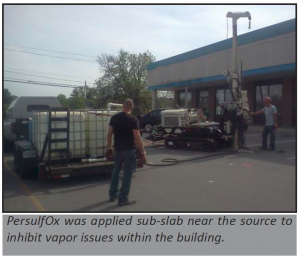
Project Summary
A release of PCE from a former dry cleaning operation in Indianapolis resulted in groundwater contamination below the facility and downgradient. Contamination impacts were also observed in shallow fill below the concrete slab. Along with the groundwater/soil contamination, vapor intrusion was also detected within the facility and adjacent spaces in the strip mall. A combination of enhanced reductive dechlorination (ERD) and in situ chemical oxidation (ISCO) was used for remedial action. Analytical results obtained indicate nearly complete reduction of PCE and less than 10 ppb of TCE in all wells. Per the recent sampling event, VC concentrations have dropped in all wells. Monitoring is ongoing.
Remediation Approach
PersulfOx® Catalyzed Persulfate was injected below the floor slab of the dry cleaner to inhibit vapor production within the facility and adjacent spaces. 3-D Microemulsion® and Bio-Dechlor INNOCULUM® Plus were injected into the uppermost water-bearing area below the dry cleaner and into two areas downgradient on either side of the building. Supplemental ERD injections were applied in two areas approximately 9 months after the initial injection to address minor sand stringers that were contributing to continued contamination impacts. The supplemental injection resulted in immediate elimination of PCE/TCE and a rapid production of VC. The site is currently being monitored to demonstrate plume stability with approximately 3-4 more monitoring events prior to site closure.
Technology Description
PersulfOx is a sodium persulfate-based chemical oxidation technology which destroys both hydrocarbon and chlorinated solvent-type contaminants in the subsurface. PersulfOx contains a built-in catalyst which activates the persulfate component and generates contaminant-destroying free radicals without the need for the addition of a separate activator.
3-D Microemulsion is an engineered electron donor material that offers a novel 3-stage electron donor release profile, pH neutral chemistry and is delivered on-site as a factory-emulsified product.
Bio-Dechlor INOCULUM Plus is an enriched natural microbial consortium containing species of Dehalococcoides sp. (DHC). This microbial consortium has since been enriched to increase its ability to rapidly dechlorinate contaminants during in situ bioremediation processes.
Combined Remedies Treatment Results in a $650,000 Cost Savings for End User
Project Highlights
- By implementing this strategy with a clear path to closure, KERAMIDA saved their client approximately $650,000 versus the alternative containment plan. KERAMIDA’s sophisticated and aggressive remedial approach matched the technologies (ISCO, ISCR, ERD) to the technical challenges at the site.
- PCE was virtually eliminated in most other impacted wells, and continued evidence of reductive dechlorination is ongoing.
- Project currently in the monitoring phase to establish plume stability for closure.
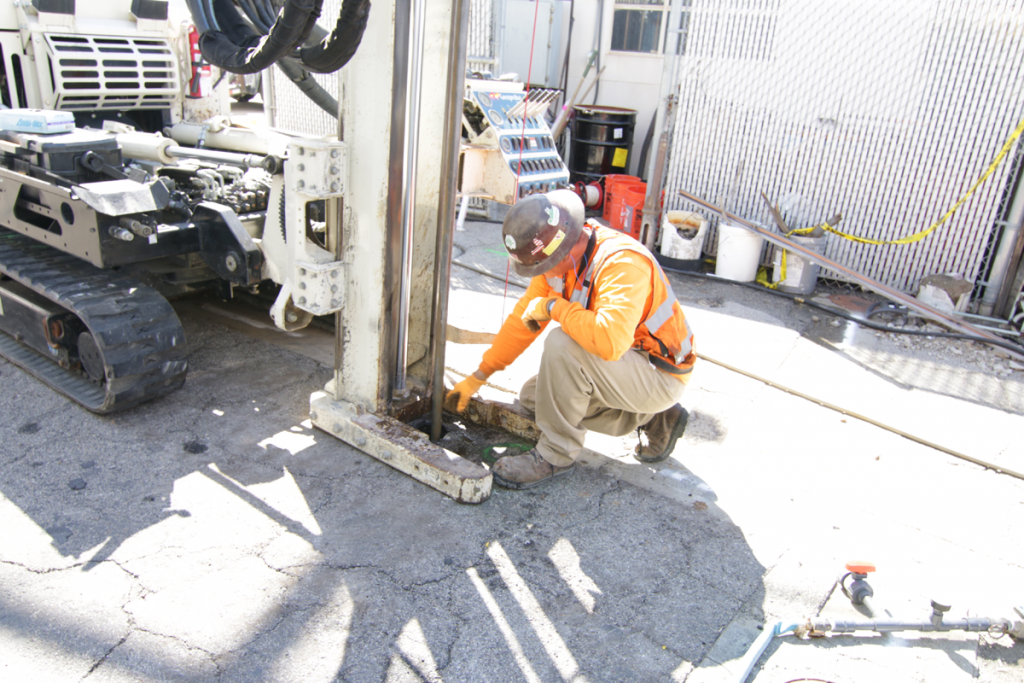
Project Summary
A PCE spill from a 55 gallon drum in the late 1980s contaminated a manufacturing site in Indiana. Contaminated soil was excavated in the spill area and a pump and treat interceptor system was installed downgradient of the plume. The system continued to operate intermittently throughout the 1990s. A previous consultant had submitted a remediation work plan proposing the use of a permeable reactive barrier. However, the plan was rejected because the intended goal was remedial closure, not containment. KERAMIDA proposed a combined in-situ chemical oxidation (ISCO)/enhanced reductive dechlorination (ERD) approach focusing on the spill area (source) and the downgradient, on-site plume, with a small injection off-site. The remediation plan was approved and the injection was completed in November 2013. KERAMIDA’s cost to closure is likely to be achieved for less than $500,000 – saving $650,000-800,000 over the life of the project. (The rejected remediation plan from the previous consultant had an estimated cost of $1.3 million with no plan for closure.)
Remediation Approach
The combined remedies treatment included an initial application of PersulfOx® Catalyzed Persulfate in the source area with subsequent applications of 3D Microemulsion® (3DME), BioDechlor INNOCULUM® Plus (BDI-Plus) and Chemical Reducing Solution (CRS®). In addition, 3DME and BDI-Plus were applied in two downgradient areas of the plume. Groundwater monitoring performed in the eight months since injection indicates dramatic reductions in PCE concentrations. Within the source area, an initial PCE concentration of approximately 70,000 ppb was reduced to 278 ppb (with a corresponding increase in cis-1,2-DCE, which is currently being degraded). PCE was virtually eliminated in most other impacted wells and evidence of reductive dechlorination is ongoing.
Technology Description
PersulfOx is a sodium persulfate-based chemical oxidation technology which destroys both hydrocarbon and chlorinated solvent-type contaminants in the subsurface. PersulfOx contains a built-in catalyst which activates the persulfate component and generates contaminant-destroying free radicals without the need for the addition of a separate activator.
CRS is an iron-based amendment for in situ chemical reduction (ISCR) of halogenated hydrocarbon contaminants such as chlorinated ethenes and ethanes.
3-D Microemulsion is an engineered electron donor material that offers a novel 3-stage electron donor release profile, pH neutral chemistry and is delivered on-site as a factory-emulsified product.
Bio-Dechlor INOCULUM Plus is an enriched natural microbial consortium containing species of Dehalococcoides sp. (DHC). This microbial consortium has since been enriched to increase its ability to rapidly dechlorinate contaminants during in situ bioremediation processes.

 Americas
Americas Europe
Europe Français
Français Deutsch
Deutsch Italiano
Italiano Español
Español

